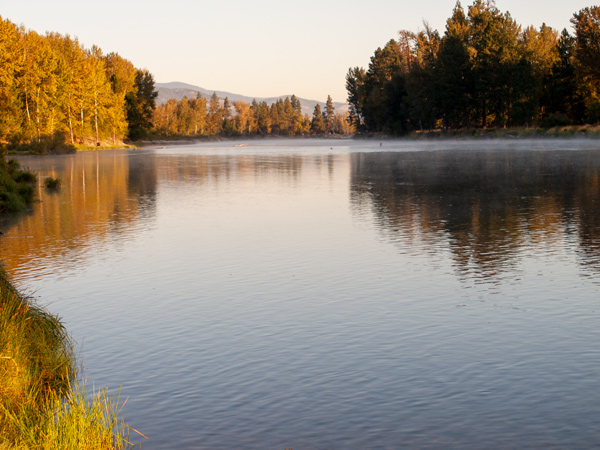Tum-sum-lech – No Salmon!
The Corps of Discovery spent the night of 3 September 1805, somewhere on the divide between the North Fork of the Salmon River and the Bitterroot drainage, which the Lemhi Shoshones had assured them was part of the Columbia River basin. On the morning of the fourth, “a verry cold morning every thing wet and frosed,” they slipped and slid down the steep, snowy Camp Creek drainage to the bank of the East Fork of the Bitterroot (“Clark’s”) River, where they came upon a camp of 400 Salish Indians and their 500 horses. “Those people recved us friendly,” reported Clark, “threw white robes over our Sholders & Smoked in the pipes of peace.” They spent all the next day talking back and forth along a language chain of five links: Drouillard or Lepage would translate from the captains’ English into French for Charbonneau, who translated from French to Hidatsa for Sacagawea, who in turn spoke Shoshone to a boy of her own tribe who was living among the Flatheads and could interpret for them in Salish.
Continuing down “Clark’s River” on 9 September 1805, they reached “a fine bould clear runing stream” that flowed from the west, where Toby, their guide, said they would leave the river to cross the mountains. On that account, Meriwether Lewis was temporarily relieved of one nagging worry. “The stream appears navigable,” he had earlier confided to his journal in reference to the Bitterroot River, “but from the circumstance of their being no sammon in it I believe that there must be a considerable fall in it below.” His conclusion was questionable. In fact, biologists have not yet satisfactorily explained why sea-run salmon have never been seen in the Clark Fork-Pend Oreille River basin.[1]There is, however, a genus of salmonids known as char or bull trout (Salvelinus confluentus) which is native to all parts of the Columbia River basin. Some of its population spawns in many of the … Continue reading
It was not yet winter, the Indians’ story-telling season, so Lewis and Clark would not have heard the Salish coyote legend that accounted for the absence of salmon in those waters. A hundred years later, however, it was related to Olin D. Wheeler around 1901 by the honorable Judge Frank Woody, of Missoula, Montana, who learned it from a member of the Bitterroot Salish band of Indians.[2]Reprinted in Wheeler’s travelogue, The Trail of Lewis and Clark, 1804-1904 (New York: G. P. Putnam’s Sons, 1904), 2:79-80. As Judge Woody paraphrased it, it read as follows:
It appears that the Coyote married. His alliance was a love match, but he was a fickle fellow, and when two sons arrived he showed no inclination to support them or his wife. The wife, however, invoked higher authority and compelled Coyote to provide for his family. He complained bitterly, and told his troubles to the spirits across the range. They sympathized with him, and gave him a salmon that he was to take and place in the stream Tum-sum-lech, to furnish food for his wife and children. The only condition that was imposed upon him was that when he took the salmon across the range, he should not look back. It was the same injunction that was given to Lot’s wife.[3]In thoughtless defiance of an angel’s command, Lot’s old wife, Sarah, looked back upon the burning cities of Sodom and Gomorrah, and was turned into a pillar of salt. Genesis 19:17, 26; … Continue reading Coyote missed just as the woman of Scripture did. He took the salmon in his mouth and climbed the western side of the range. He kept his eyes frontward till he reached the summit. Then the demands of nature compelled him to pause. He stopped and laid down the salmon. At that instant he thoughtlessly cast his eye back to the valley that he had just left. As he did so, the salmon slipped down the mountainside and back into the Clearwater. the opportunity for stocking the stream with salmon was lost, and so it was called Tum-sum-lech–No Salmon. This name became forgotten favor of the simpler one, Lolo, that remains to-day.
It is worth noting that Indian place-names are not normally used as labels, but as reminders of stories believed to have arisen in certain natural places.[4]This coyote story is reminiscent of the ancient myth of Orpheus and Eurydice as told in Ovid’s Metamorphoses (AD 8), which in turn was based on much earlier tales used to teach the power of … Continue reading For that reason we may suppose that the irrelevant final sentence of the story as recounted above may have been added purely for the white reader’s benefit by the well-meaning Judge Woody.
Notes
| ↑1 | There is, however, a genus of salmonids known as char or bull trout (Salvelinus confluentus) which is native to all parts of the Columbia River basin. Some of its population spawns in many of the cold, clear headwaters in the Rockies, and may reach 4 pounds in weight in streams and rivers, and 20 pounds in large lakes. Lewis and Clark did not recognize this species anywhere. |
|---|---|
| ↑2 | Reprinted in Wheeler’s travelogue, The Trail of Lewis and Clark, 1804-1904 (New York: G. P. Putnam’s Sons, 1904), 2:79-80. |
| ↑3 | In thoughtless defiance of an angel’s command, Lot’s old wife, Sarah, looked back upon the burning cities of Sodom and Gomorrah, and was turned into a pillar of salt. Genesis 19:17, 26; Luke 17:28-32. |
| ↑4 | This coyote story is reminiscent of the ancient myth of Orpheus and Eurydice as told in Ovid’s Metamorphoses (AD 8), which in turn was based on much earlier tales used to teach the power of faith and self-confidence, and the consequences of doubt and timidity. See Joseph Campbell, The Hero with a Thousand Faces (New York: MJF Books, 1949), pp. 206-07, and “The Crossing of the Return Threshold,” pp. 217-228. |

